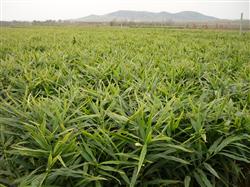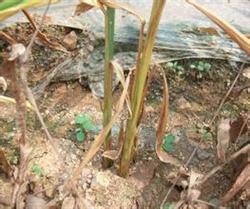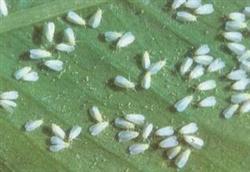The technique of "four changes" is skillful in planting warm spring turmeric

In recent years, the situation of earning foreign exchange from the export of high-quality turmeric is good, but the demand for quality is getting higher and higher. Our department instructs 20 big growers to promote the use of the new technology of "four changes", so that the big ginger produced is obese, the skin color is shiny, the average yield per mu is 64% higher than that of traditional planting, and the income of ginger farmers has doubled. The spring blooming season from March to April is the golden season for sowing ginger. The measures of "four changes" are introduced as follows for ginger farmers' reference. The main results are as follows: 1. Change the traditional ditch sowing to ridge planting. According to the characteristics of short and shallow root, afraid of waterlogging and early, the traditional furrow sowing is changed to ridging planting, and the ridge distance is 65-70 cm, the pier distance is 20-25 cm, and 4000-5000 piers per mu is better. Through ridging, the living soil layer is greatly increased, so that the soil is loose, the irrigation is not hardened, and the drainage is very smooth. The ginger block grows in the soil layer where water, fertilizer, gas and heat are more coordinated, which is very beneficial to the expansion of ginger block and the thick and short ginger ball. This measure alone can increase the yield of ginger by more than 30% compared with traditional furrow sowing. 2. Change the thin land planting to fertile soil cultivation. According to the characteristics that ginger is the yield of rhizome formation and likes loose fertilizer and living soil, it is necessary to increase the amount of fertilizer application and deepen the living soil layer. Therefore, the plot should be deeply ploughed and leveled before sowing, with more than 500 kg of organic fertilizer per reservoir, 50 kg of bean cake and 50 kg of compound fertilizer before ploughing. After that, it is necessary to chase seedlings, attack trees and attack chunks of fertilizer more than 100 kilograms in time in order to meet the needs of ginger's growth and development and greatly improve its yield and quality. 3. Change small pieces of ginger to large pieces of ginger. Ginger is asexual reproduction, and its growth at seedling stage mainly depends on "ginger mother" to provide nutrition. The selection of large and obese ginger species when planting is a simple and easy measure to increase production. The experiment showed that the yield of ginger increased with the increase of the weight of ginger, and the yield of 150 g ginger was more than 15% higher than that of 100 g ginger. At the same time, the weight of ginger species also has a greater impact on the yield, the same weight of 150 grams of ginger, fat than thin increased by nearly 20%. The reason for increasing production is very simple: "the mother is big and the son is fat", the seedlings are thick and strong, the branches are many and fast, and the photosynthetic area is large. Therefore, ginger species had better choose shiny skin color, fat block, block weight of more than 100 grams of seed, do not use small pieces of lean ginger as seeds. 4. Change extensive planting to careful management. In order to achieve high yield, it is very important to adjust "water, fertilizer, gas and heat". One is to conserve water. Spray seedling water frequently in seedling stage, spray warm water frequently in hot summer, spray inflated water in the later stage; second, topdressing. In addition to applying sufficient base fertilizer to the field, but also according to its different growth periods, timely application of seedling fertilizer, attack fertilizer and block fertilizer; third, ventilation. To hoe the soil frequently and cultivate the soil shallowly, so as to loosen and aerate the soil and promote growth; fourth, it is necessary to control heat. In the hot summer season, we should not only take measures to shade sugarcane, but also frequently pour warm water to avoid high temperature sprouting. In addition, in the prevention and control of diseases and insect pests, special attention should be paid to the selection of low-toxic and low-residue pesticides such as Yitaibao, agricultural streptomycin and pyrethroids, so as to ensure the healthy growth of ginger.
- Prev

Control of Ginger Stem Rot
In recent years, with the continuous expansion of ginger continuous cropping area and extensive field management, the disease of ginger is also aggravating, especially since June, because of high temperature and rain, ginger stem rot is the most likely to occur. Recently, Li Hualiang and Lu Changlei in Renzhao Town, Pingdu City, Shandong Province, and Yu Wanquan in Ju County reflected that.
- Next

Why the growth of parsley seedlings is different
Characteristic description and control methods are also called small white moths. Adults and nymphs absorb plant juice, make leaves fade, turn yellow and wilt, secrete a lot of honeydew and pollute fruits and leaves. Native to southwestern North America, it was later introduced into Europe and is now widely distributed all over the world. In the north, greenhouses can give birth to more than 10 generations a year.
Related
- Where is it suitable to grow horseradish in China? it is expected to see the middle altitude horseradish in Alishan.
- How to prevent tomato virus disease reasonably? (Control methods included)
- Many people like to plant towel gourd on the balcony. What are the main points of this method and management?
- What crops can chili peppers be mixed with?
- Fertilization techniques and matters needing attention in Tomato
- What are the grafting techniques for peach seedlings in spring?
- Harm and control methods of root swelling disease of Chinese cabbage
- What are the pests of sweet potatoes? How to prevent and cure it?
- Symptoms, causes and Control methods of navel Rot in Tomato
- The cause of "Cucumber rotten bibcock" in Farmers' planting Cucumber and its Control Plan

